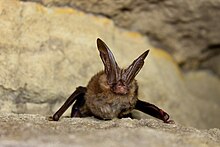Corynorhinus townsendii virginianus
| Virginia big-eared bat | |
|---|---|
 |
|
| Photo of a Virginia big-eared bat roosting at a large hibernaculum | |
| Scientific classification | |
| Kingdom: | Animalia |
| Phylum: | Chordata |
| Class: | Mammalia |
| Order: | Chiroptera |
| Family: | Vespertilionidae |
| Genus: | Corynorhinus |
| Species: | C. townsendii virginianus |
The Virginia big-eared bat (Corynorhinus townsendii virginianus) is one of two endangered subspecies of the Townsend’s Big-Eared bat. It is found in West Virginia, North Carolina, and Kentucky. In 1979, the US Fish and Wildlife Service categorized this as an endangered species. There are about 20,000 left and most of them can be found in West Virginia. The Virginia Big-Eared Bat is the state bat of Virginia.
The Virginia Big-Eared Bat has light to dark brown fur depending on age. Their fur is long and soft and the same from its base to its tip. This species is one of the largest cave-dwelling bats in its range, and weighs between 7 and 12 grams. The bat is recognized by its big ears, which are over 2.5 centimeters long. Their ears reach back to half the length of their body when at rest. It also has a globular shaped muzzle and elongated nostrils. Its whole body is 98 millimeters long. The forearms of the bat are anything from 39 to 48 millimeters, the tail can be about 46 millimeters, and the hind foot can be about 11 millimeters.
Mating happens in the fall and the winter. Females ovulate in the winter and the spring and can store the sperm from the male until then. The bats are pregnant for 3 months and have their one pup in May or June. In 2 months the pups fully develop and are able to fly from their roost.
These bats live in caves throughout the whole year and prefer caves surrounded by oak-hickory forest. They are usually located in mountainous limestone regions. During the maternity period the female bats stay in the caves. Most male bats don’t stay with the female bats during this period. They aren’t migratory and usually stay close to their caves. In the winter this species hibernates rather than migrates. Usually these bats only leave to hunt for food.They are nocturnal hunters and feeders. In Virginia they are known to hunt in fields and in Kentucky they are known to hunt by cliffs. Research shows that hunting patterns are very varied. They use their sonar to see insects while flying on the edges of the forests where they hunt. They benefit us because they hunt harmful insects. They hunt for insects such as: small moths, beetles, flies, lacewings, bees and wasps.
Threats to this species include disturbance from noise, bright lights, and human presence.
...
Wikipedia

